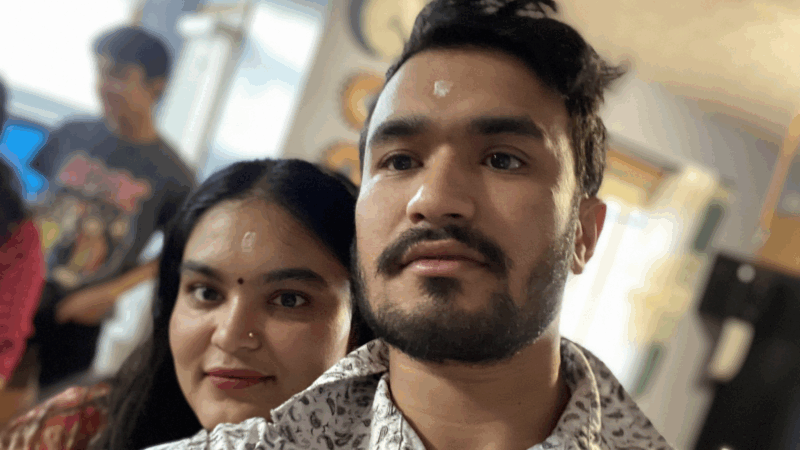Autism: Diagnosis
Before her son Walker was born in the fall of 1996, Patricia Stacey knew little about autism. Stacey had images of a silent child rocking back and forth, withdrawn from human affection. Within hours of Walker’s birth, STacey’s life and outlook would change forever.
“I had some inklings almost the moment he came out. He looked right past me. And later in the hospital when he was nursing, he wouldn’t look me in the eye. …and then about the time he was 3 months old…. I had him in a basket in the bathroom, and I heard this really loud thud, and I realized he’d fallen on his head, and I waited for that screaming that always came with my daughter….but it never came. Instead, he just laid there frozen… And I knew something’s really wrong here.”
Stacey and her husband Cliff consulted their pediatrician, who told them not to worry. But then the couple began to notice Walker’s strange obsession with light.
“He would lie and stare always look out of windows, and he would always orient himself so he was staring at light… it was like a needle of a compass. I was always trying to figure out how I could get in between that light and Walker.”
She waited for him to start recognizing her, and he never did. So Stacey turned to the Reach Program, a community-based service in that provides developmental therapy. STacey remembers Walker’s first visit.
“He was diagnosed by them as having sensory integration disorder, and I went for a few days thinking, oh, that doesn’t sound too bad. …and Cliff said, ‘I don’t think we’re out of the woods yet… I looked up sensory integration disorder, and it’s cross referenced constantly with autism.’ It really hit me hard.”
Stacey was entering a controversy over how young a child can actually be called autistic…. something she would later focus on in her new memoir, “The Boy Who Loved Windows”. The diagnosis itself is complicated. Children can experience a range of problems. Some are oversensitive to touch or sound. They may lack empathy or never make eye contact. Some can’t speak or, at least, not in a meaningful way. But the question many doctors ask is: At what point can you confidently diagnose a child as autistic — without panicking parents needlessly? Karen Blum is an Amhert child pscyhologist. She says children develop at different rates, and most aren’t diagnosed with autism before they’re 18 months old.
“A label can sometimes be a self-fulfilling prophecy. It can limit the expectations one sets for a child….At the same time, we know early intervention makes a difference.
“I wanted them to diagnose him with the worst possible case scenario so we could start fighting it.”
When Stacey’s son was almost a year old, she visited Dr. Stanley Greenspan, a prominent child psychiatrist in Maryland and author of “The Child with Special Needs”. He treats infants whom he considers at risk for autism – those who consistently miss key emotional and social milestones.
“You don’t want to think of diagosing a four month old, or six month old, or eight month old, but you want to think of the degree of risk. In that way, you’re not labeling a child at a young age, but you’re saying, we have increased risk now, and let’s help this baby back on a healthy developmental path.”
After he determined Walker was at risk for autism, Greenspan worked with the family to teach Walker cognitive and social skills. Today, Walker is a well-adjusted first-grader… in public school… and at home. Stacey is convinced that labeling Walker disabled as an infant is waht saved him from a lifelong disability.
“I recently did a book reading in Denver, and a couple came with their autistic son, in a wheelchair, who spent most of his time holding a rubber band between his fingers, playing with a paper clip between his lips. i’ve had a lot of professionals tell me, had we not done the intensive work we did in his early years, he would be mentally retarded….I sometimes wonder, would he be one of those kids in the wheelchair?”
But Stacey’s claim has its skeptics. Even administrators at the Reach Program are guarded in talking about Walker’s success. Anne Morehouse, who directs the autism program at Reach, wonders if Walker was every really autistic.
“It’s hard to know, did that child make so many gains because of the intervention, or did that child make so many gains bc he was ready for that, because of how he was made up, and I think one of the dangers is that parents will read this and think, my child can be cured!”
But some say being too cautious is also dangerour — you lose precious time. Linda Castronovo believes she missed autistic signs in her son Andrew for his first four years.
“He would have intense tantrums, but they were just intense crying, and would pass quickly. Then as a toddler, he wasn’t connecting with his peers in the playgroup …. He was slow to talk too, but the pediatrician — five to six words, that’s within normal bounds.”
Autism experts say that few pediatricians are trained to recognize signs of the disorder until they are extreme. At age three, Andrew began to hit other children — randomly and aggressively — and was asked to leave different pre-schools. At first, he was diagnosed with attention deficit disorder. Then Castronovo consulted a child psychologist in Amherst.
“He said, I’m thinking lots of things, I’m thinking anxiety, obsessive compulsive,
autism – and I was like, I just screamed in my head, there’s no way he’s autistic.”
Andrew was eventually diagnosed with Asperger’s Syndrome, a high-functioning form of autism characterized by social withdrawal and intense absorption in certain subjects. On the one hand, the label was devastating.”
“It was a rollercoaster of accepting and denying. Accepting and denying….I still have this feeling that says, I want him to pass for normal. Where no one would know that he ever walked with this label.”
On the other hand, the diagnosis got Andrew occupational therapy paid for by insurance. And after two years of therapy at home, he was able to enter the public schools – with the assistance of a personal aide. But Castronovo says his reactions are still volatile, and his friendships seem emotionally detached.
“I believe the brain is malleable our entire lives, but I think the degree to which it’s malleable changes….So when I think, had we started earlier, would he have a different outcome? I don’t know.”
That’s one question facing researchers, who are continuously revising their definition of autism. Is it an inherent characteristic that can’t be altered, like genetic coding, or is it a severe learning disability that – if treated – can eventually make way for normal social and cognitive development? The answer, many say, could like in how well the increasing number of therapies are shown to help autistic children.
Fire-making materials at 400,000-year-old site are the oldest evidence of humans making fire
Archaeologists in Britain say they've found the earliest evidence of humans making fires anywhere in the world. The discovery moves our understanding of when humans started making fire back by 350,000 years.
Senate to vote on dueling health care proposals as ACA premium hikes loom
The Senate is set to vote on dueling health care proposals. Both plans are likely to fail, even as Affordable Care Act premiums are set to skyrocket at the end of the year.
Elizabeth Warren says both bids to buy Warner Bros. Discovery are bad for consumers
Sen. Elizabeth Warren cautions that the sale of Warner Bros. Discovery to either Netflix or Paramount Skydance could reduce competition and concentrate power over what films and news American see.
This refugee’s family faced persecution in Bhutan. Now, he could be deported there
Mohan Karki's family and others with Nepali ancestry were persecuted and driven out of Bhutan in the 1990s. Karki himself was born in a refugee camp in nearby Nepal. Yet, the U.S. government claims he is a Bhutanese citizen and seeks to deport him there.
Trump calls affordability crisis a “hoax,” touts the economy ahead of midterms
As Democrats campaigning on affordability pick up wins, Trump's messaging about a strong economy is at odds with widespread voter sentiment that he's not doing enough to tackle rising costs.
Will U.S. military strikes slow drug overdose deaths? Experts say no
President Trump says U.S. strikes on supposed drug-smuggling boats will save Americans from overdose deaths. But most experts worry the strategy is counterproductive.








